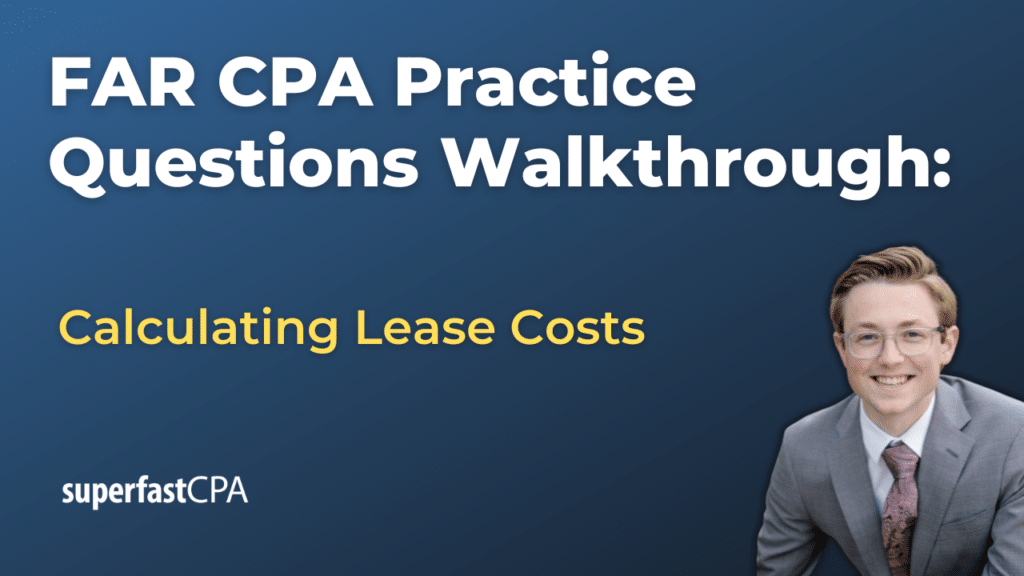In this video, we walk through 5 FAR practice questions about calculating lease costs. These questions are from FAR content area 3 on the AICPA CPA exam blueprints: Select Transactions.
The best way to use this video is to pause each time we get to a new question in the video, and then make your own attempt at the question before watching us go through it.
Also be sure to watch one of our free webinars on the 6 “key ingredients” to an extremely effective & efficient CPA study process here…
Calculating Lease Costs
Calculating the lease costs that a lessee recognizes in the income statement involves understanding several key concepts: amortization of the Right-of-Use (ROU) asset, amortization of leasehold improvements, the effect of lease incentives, and the calculation of interest expense for finance leases. Below, we’ll break down these aspects with explanations and examples.
Amortization Expense for the ROU Asset
When a lessee enters into a finance lease, the ROU asset must be amortized over the lease term unless the lease contains a written purchase option or ownership transfers to the lessee at the end. If ownership transfers in one of those ways, the ROU asset is amortized over the asset’s useful life.
Example: A company enters into a finance lease for equipment. The lease term is 8 years, and the equipment’s useful life is 10 years. The lease does not include a written purchase option, and ownership does not transfer. The present value of the lease payments is $240,000.
- Amortization Period: Since there is no ownership transfer or purchase option, the ROU asset is amortized over the lease term (8 years).
- Annual Amortization Expense: $240,000 ÷ 8 = $30,000 per year.
If ownership transferred, the amortization period would be the useful life (10 years), and the expense would be $24,000 per year.
Amortization of Leasehold Improvements
Leasehold improvements are amortized over the shorter of their useful life or the lease term unless a renewal is reasonably certain. This ensures the expense reflects the time frame during which the improvements provide benefit.
Example: A business installs $120,000 of leasehold improvements with a 10-year useful life. The lease term is 6 years with no certain renewal option.
- Amortization Period: The improvements are amortized over 6 years, as it is shorter than the useful life.
- Annual Amortization Expense: $120,000 ÷ 6 = $20,000 per year.
If the lease had a reasonably certain renewal option extending the term to 10 years, the amortization period would match the useful life.
Lease Incentives and Monthly Lease Expense
Lease incentives, such as reduced or waived payments, are evenly allocated across the entire lease term. This spreads the benefit of the incentive over the lease’s duration, aligning with the principle of straight-line expense recognition.
Example: A company enters a 3-year operating lease with monthly payments of $5,000. In Year 1, the monthly payment is reduced to $4,000. In Year 2, the payment is $4,500 for the first 3 months and $5,000 for the remaining 9 months. In Year 3, the full payment of $5,000 applies.
- Total Payments:
- Year 1: $4,000 × 12 = $48,000
- Year 2: ($4,500 × 3) + ($5,000 × 9) = $58,500
- Year 3: $5,000 × 12 = $60,000
- Total Payments Over 3 Years: $48,000 + $58,500 + $60,000 = $166,500.
- Monthly Lease Expense: $166,500 ÷ 36 months = $4,625 per month.
The monthly lease expense accounts for the incentives by spreading the total payments evenly.
Calculating Interest Expense for a Finance Lease
Interest expense for a finance lease is based on the outstanding lease liability. It decreases over time as principal payments reduce the liability. Calculations often begin with the present value of lease payments.
Example: A company enters a finance lease requiring annual payments of $50,000 for 5 years. The implicit interest rate is 6%, and the present value factor is 4.2124.
- Present Value of Lease Payments: $50,000 × 4.2124 = $210,620.
- Year 1 Interest Expense: $210,620 × 6% = $12,637.
- Principal Reduction in Year 1: $50,000 – $12,637 = $37,363.
- Outstanding Principal After Year 1: $210,620 – $37,363 = $173,257.
- Year 2 Interest Expense: $173,257 × 6% = $10,395.
Each subsequent year’s interest expense decreases as the principal is reduced.
Key Takeaways
- ROU Asset Amortization: Based on the lease term unless ownership transfers or a purchase option exists.
- Leasehold Improvements: Amortized over the shorter of the lease term or the asset’s useful life.
- Lease Incentives: Spread evenly over the full lease term to calculate monthly expense.
- Finance Lease Interest Expense: Calculated based on the present value of lease payments and adjusted yearly as the principal decreases.













